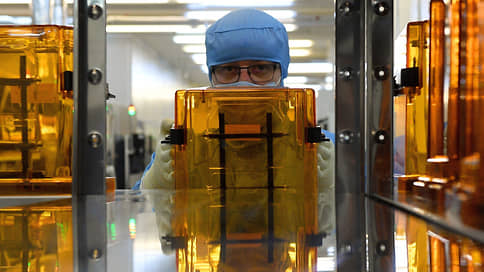Seven spans in a chip – Newspaper Kommersant No. 162 (7363) of 09/05/2022
[ad_1]

As Kommersant found out, Zelenograd Mikron, one of the few plants in the Russian Federation capable of producing chips for civil electronics, will receive 7 billion rubles. from the Industrial Development Fund (IDF). The funds will be used to “scaling up production.” Micron really needs to increase capacity amid growing orders and problems with imported chips. But experts emphasize that without the development of technologies that Mikron has far behind the world’s, it will face “stagnation and a dead end.” Especially, market participants add, against the backdrop of low salaries and staff turnover.
According to two Kommersant sources in the electronics market and in the government, VEB.RF approved the allocation of a credit line of 7 billion rubles to Zelenograd semiconductor manufacturer Mikron JSC (owned by Element Group of Rostec and AFK Sistema). for ten years. The interlocutor in the market specified that the allocation of funds is planned through the FRP on the security of production equipment, the money will go to “scaling production at the enterprise.” Mikron, FRP and the Ministry of Industry and Trade did not respond to Kommersant’s requests, and VEB.RF declined to comment.
Mikron JSC produces semiconductors in 180-90 nm topologies, this technology allows manufacturing chips for transport cards, Internet of Things equipment, as well as a narrow range of general-purpose processors (the world’s largest semiconductor factories, for example, TSMC, have already mastered the topology of 2 nm and below ). Mikron is one of the few enterprises in the Russian Federation producing microelectronics for the civil sector. The rest, for example, Angstrem, mainly work for the military-industrial complex using 600 nm technology. According to SPARK-Interfax, Mikron’s revenue in 2021 amounted to 5.69 billion rubles. with a net profit of 257 million rubles. The company received state support in the amount of 687 million rubles.
In the spring, it became known that Mikron, against the backdrop of an increase in demand for chips for bank, transport and other cards, prepared a project to double the capacity, up to 6 thousand silicon wafers per month. Kommersant’s sources estimated it at 10 billion rubles. (see Kommersant dated April 22).
The Russian authorities in the past few months have repeatedly announced plans to significantly increase investment in the microelectronics segment. “The industry will receive unprecedented funding, and it is long-term – we have made plans for eight years,” Prime Minister Mikhail Mishustin said on August 31 (quoted by RIA Novosti). Kommersant’s interlocutors, close to the Ministry of Industry and Trade, add that the authorities will publicly announce plans for “large-scale financing of the industry” as part of a new national project in October at the Microelectronics-2022 forum.
According to Yaroslav Petrichkovich, the founder of the Elvis Design Center, Mikron’s products can now cover “a certain segment of the Russian electronics market, primarily components for equipment for critical infrastructure and the defense sector.” But, the expert emphasizes, 7 billion rubles is “an extremely small amount for the development of such enterprises.” APKIT Association Director Nikolai Komlev agrees that there are many tasks that can be completely solved using technologies already mastered by Micron. However, he clarifies, state support is needed not only to scale production, but also to master new technologies: “If this parallel process does not exist, stagnation and a dead end will come.”
Olga Grekova, head of ANO Consortium Lighting Engineering, draws attention to more mundane but urgent goals: “The shortage of personnel, which domestic manufacturers of electronic components experienced before, has intensified. As far as I know, a number of companies are requesting subsidies to increase the salaries of employees who maintain production equipment.” The expert explains that the average wages at such enterprises are about 50-60 thousand rubles, and after several years of work, employees leave for “other companies at high rates.”
[ad_2]
Source link





